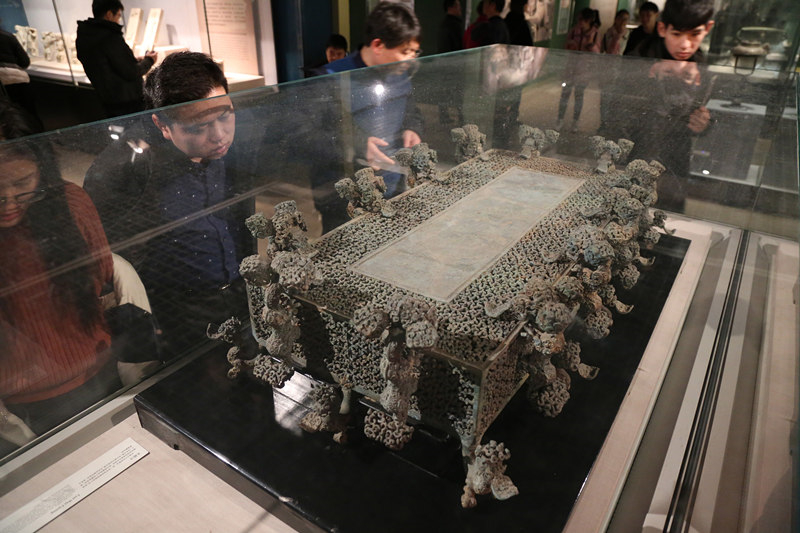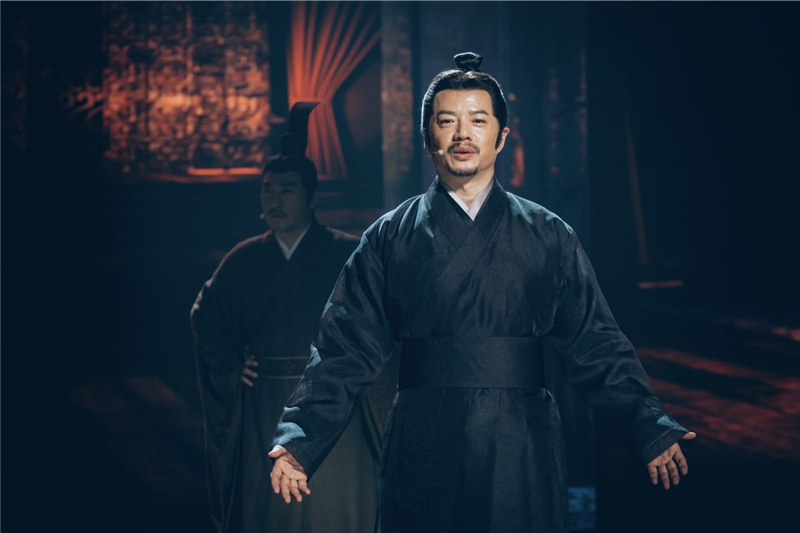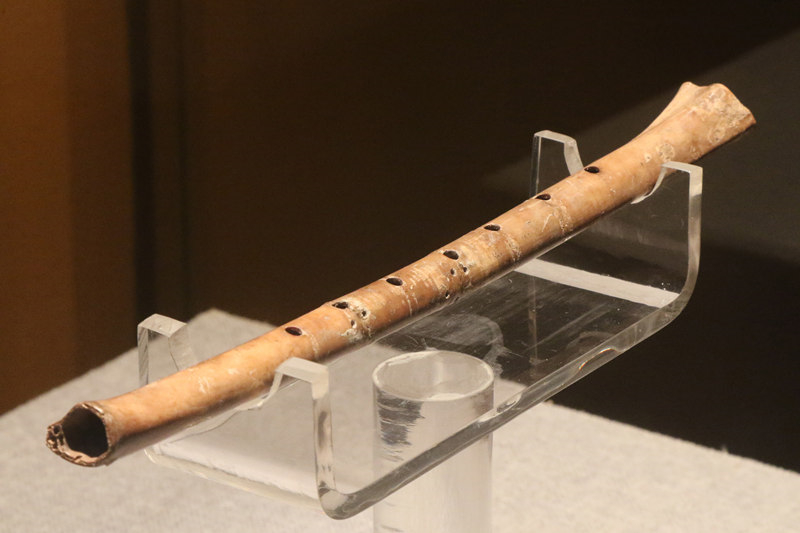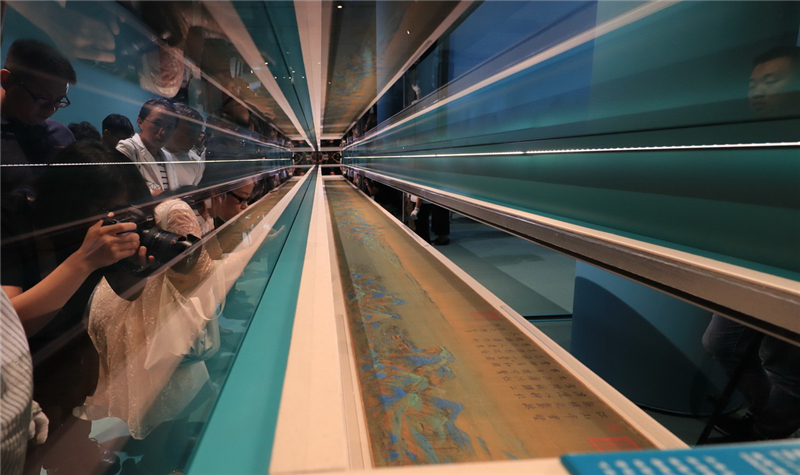Actor Duan Yihong delivers a monologue as the Spirit of the Sword of Goujian in the show National Treasure. [Photo provided to China Daily]
National Treasure has Chinese television audiences fired up. But don't confuse it with the Hollywood action film from 2004 of the same name. In that film, Nicolas Cage painstakingly sneaks into museums, steals artifacts, and discovers the hidden history of the United States going back around 250 years.
In the Chinese variety show, producers at China Central Television are lucky: China has a much longer history, and their proposal to "borrow" artifacts was welcomed by nine top-tier museums, which were eager to help make their collections come alive.
The museums that participated were the Palace Museum in Beijing, also known as the Forbidden City, and eight key province-level museums.
A visitor takes photo of an owl-shaped bronze wine holder owned by Fu Hao, a legendary queen and general in the Shang Dynasty (c. 16th to 11th century BC) at Henan Museum, Zhengzhou. [Photo provided to China Daily]
Since its premiere on Dec 3, the ambitious variety show-airing Sundays at 7:30 pm on Channel 3 of CCTV-has been rated 9.2 points out of total 10 on douban.com, a major TV and film critic site.
In each 100-minute episode, three key exhibits from a museum are introduced by entertainment stars through short stage dramas.
The dramas portray the history of the legends behind the items.
Yu Lei, director of the show, explained how items are chosen: "Our standard is not to choose the most precious item. We want the ones with most attractive stories.
"If people are bored, there is something wrong with our methods," she said.
In a segment on A Panorama of Rivers and Mountains, a well-known Chinese painting now housed in the Palace Museum, actor Li Chen plays Emperor Huizong of the Northern Song Dynasty (960-1127).
Historical records show Wang Ximeng, the man behind the painting, was a student at the royal painting academy who failed to produce satisfactory work. But his potential was discovered by Huizong. Under the emperor's tutelage, the 18-year-old budding genius completed this milestone in Chinese fine art history within half a year.
Yu described the episodes as similar to docudramas, with elements such as dialogue that are fictionalized while the storylines are based on historical information. "These cultural relics are like aged people. They have so much to tell us."
Sometimes, comedy is also employed.
When Wang Kai plays Emperor Qianlong of the Qing Dynasty (1644-1911) in a section about a porcelain vase commonly called the "mother of porcelains", he has a dream in which he is roundly rebuked for his taste by artists and his father. The taunts sound like those used recently by Chinese netizens.
A 7,800-year-old bone flute found in Jiahu relics is the earliest discovered Chinese musical instrument. [Photo provided to China Daily]
Still, the show corrects misperceptions about Qianlong and uses the vase as an example of inclusiveness.
Choosing the right performer for each item is itself a fine art, Yu said. They are called the "guardians of the relics".
Duan Yihong, an actor known for his portrayals of subtle emotion, was chosen to play a sword spirit who has a long monologue. The sword belonged to Goujian, a king in the Spring and Autumn Period (770-476 BC), who suffered humiliation before defeating his adversary.
Tourists view the painting A Panorama of Rivers and Mountains in the Palace Museum in Beijing in September. [Photo by Cheng Gong/For China Daily]
And, Sa Beining, a TV anchor who became famous for a program about the law, was given the task of introducing Qin Dynasty (221-206 BC) bamboo slips, which were used to write on. They were frequently used for legal documents, and Sa plays a civil servant from that period.
"Despite being big shots, the celebrities are humble. They carefully study their scripts," Yu said.
Some lesser-known stories on how the items were unearthed are also featured in the show.
In one episode, Hong Kong actor Tony Leung Ka-fai plays Northern Song Dynasty politician Sima Guang, who preserved a stone carved with hundreds of characters dating back to the Qin state during the Warring States Period. The stone had been lost and rediscovered several times before it was preserved by Sima.
In the episodes, experts also speak about the artifacts. Ordinary people are also invited on stage to share their stories linked to such relics.
"When people see cultural relics in this lively ways, they feel history," said Shan Jixiang, director of the Palace Museum.
Yu said the aim of the show is not so much to create a hit program but to attract more people to museums.

A bronze jin with cloud-shaped decorations, a table to hold wine during rituals, is displayed at Henan Museum in Zhengzhou last month. [Photo by Zuo Dongchen/For China Daily]
More seasons of National Treasure are planned, and some treasures from the show are to be featured in a touring exhibition soon after the first season ends.
Luo Jing, director of museums at the State Administration of Cultural Heritage, said: "This attempt is like cooperation between 'national teams' of the media and protectors of cultural relics. Such a cultural treat can help nurture the public's consciousness and better promote our traditions."
Yan Jingming, the vice-chairman of the China Writers Association, said National Treasure is highly praised because of its mixture of traditional and modern culture.
"Knowledge, entertainment, taste and an accessible approach have been put together in one show," Yan said.
"Cultural relics are given unique characteristics in the stories. That's how we revitalize cultural heritage and begin a dialogue between the past and today.
"Our cultural self-confidence does not fade away," he said. "A show like this fuels people's pride in their heritage."





















